


Footwork:
Basketball is played on the fingertips and the balls of your feet. Everything you do involves correct footwork. Some players are naturally quicker than others. But a player's effective quickness can be greatly enhanced if he/she uses proper footwork.>
1-You should have your weight on the balls of your feet (the front part of the foot near the toes)
2- The feet should be shoulder width apart with the knees flexed.
3-The head is centered above the lower body.
4- And your hands are about chest high with your elbows bent and your arms close to your sides.
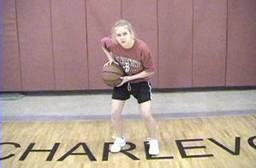
Ready position:
You should develop the habit of always going straight into the "triple threat" position when you get the basketball.
The triple threat position is,
1-Facing the basket
2-Feet about shoulder width apart.
3-Knees bent, keep your "behind" low.
4-Stay on the balls of your feet, don't stand flat-footed.
5-Keep your head up - looking around the court.
6-Holding the ball in the "ready" position, if closely guarded protect it on your back hip.
From the triple threat position you can,
1-dribble (drive to the basket) 2-pass 3-shoot
Remember to always "square up" to face the basket
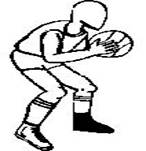 .
.
Catching and passing:
Obviously catching and passing will be practiced as a unit with the emphasis being placed on one or the other.
Catching the basketball:
Handling the ball quickly and confidently is the basis for practically every basketball skill.
A good catch will also help to keep the opposition away from the ball.
STEP ONE
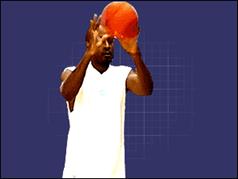
Hold your hands out in front of you with your fingers spread wide, nice and relaxed.
Using the pads of your fingers, your non-shooting hand should find its way onto the side of the ball.
It is important to try and get your shooting hand behind the ball, with the palm facing the front.
This allows you to cushion the ball with your stronger hand and improve your control.
STEP TWO
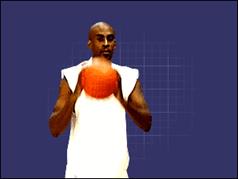
After gaining control of the ball, you will be in a good position to either pass or shoot.
With plenty of practice the ball will become your best friend.
Passing in basketball:
The chest pass
Passing get the ball up the court a lot faster than dribbling and the chest pass is the safest and most accurate pass in the game.
The easiest pass to catch is one received at chest level. It's extremely difficult to catch the ball near your feet and higher, loopier balls are more easily intercepted.
STEP ONE
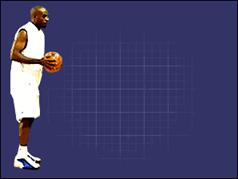
The ball should be held close to your chest.
Your fingers should be spread comfortably around it, shielding the ball.
STEP TWO
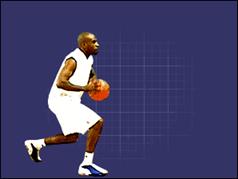
Take a step forward as you release the ball and extend your arms sharply as you push the ball towards your team-mate.
Keep your eyes on the receiver as you make the pass - watching the ball is likely to send it astray.
STEP THREE
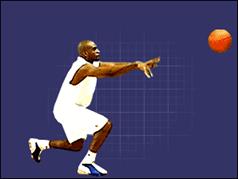
As your arms straighten, finish the pass with the wrists snapping inward.
Aim to keep your thumbs together and pointing downwards. Your fingers should be pointing towards your target.
The chest pass
Passing get the ball up the court a lot faster than dribbling and the chest pass is the safest and most accurate pass in the game.
The easiest pass to catch is one received at chest level. It's extremely difficult to catch the ball near your feet and higher, loopier balls are more easily intercepted.
STEP ONE

The ball should be held close to your chest.
Your fingers should be spread comfortably around it, shielding the ball.
STEP TWO
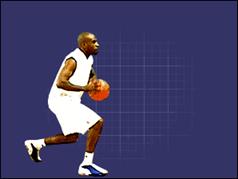
Take a step forward as you release the ball and extend your arms sharply as you push the ball towards your team-mate.
Keep your eyes on the receiver as you make the pass - watching the ball is likely to send it astray.
STEP THREE
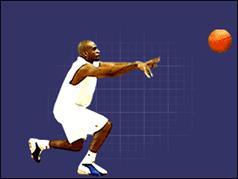
As your arms straighten, finish the pass with the wrists snapping inward.
Aim to keep your thumbs together and pointing downwards. Your fingers should be pointing towards your target.
Chest Pass
The chest pass is used only when you have a clear path to the receiver.
1.-The ball is held close to the chest, keep your elbowsclose to your body - no "chicken wings".
2-The ball is held in both hands. Hands either side of the ball, fingers spread, thumbs behind the ball. Use the fingers and thumbs to hold the ball, don't use the palms of the hands.
3-Step towards the target and thrust the arms forward.
4-As you pass the ball snap your wrists so that the palms face outward, fingers point towards the target and the thumbs face down.
5-Ball should be aimed above waist height and below shoulder height.

The bounce pass:
This is a very handy passing skill, particularly when you are tightly marked.
It is also very effective when you are dribbling, and can be used with either one or both hands.
STEP ONE
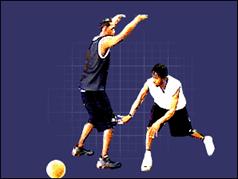
The trick is to fake a move which draws the defender one way, then pass the ball underneath their outstretched arms.
Bend your knees and extend your arm to the side of your body to give you the space and angle to make the pass.
STEP TWO
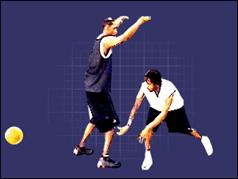
Use your fingers to push the ball downwards to your team-mate.
The ball will slow after bouncing, so aim to hit the floor about two-thirds of the way to the receiver. This reduces the risk of your opponent intercepting the ball.
Stay focused on who you are passing to.
Bounce Pass
The bounce pass is useful for going underneath the arms of a defender.
Execution is the same as a chest pass except the arms are thrust out and down, so that the ball hits the floor about two-thirds of the distance to the receiver.
The ball should come up to waist level for the receiver.

The overhead pass:
This pass is great for players wanting to get the ball over smaller or close-marking opponents.
Be careful when using this pass because it is easy for a defender to protect the area directly above them and intercept the ball.
STEP ONE

Begin the pass with the ball held by both hands above your head.
Cupping the underside of the ball with your fingers will help to keep the ball away from your marker.
STEP TWO
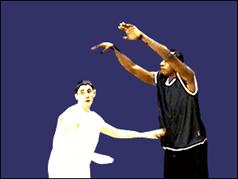
The ball should be released from behind your head.
Much of the power and direction comes from flicking your wrists and fingers, but there should be a slight forward movement of your arms.
Remember to keep your eyes on the receiver.
The Overhead Pass
The overhead pass is useful when closely guarded, especially if you are taller than your opponent.
It is also very useful for an "outlet" pass after a defensive rebound.
1-Hold the ball with both hands, using the finger pads and thumb on the outside of the ball.
2-Hold the ball above your forehead, not behind your head where it is easily stolen.
3-Step towards your target and pass the ball with a snap of the wrist and flick of the fingers.
4-After you have thrown the ball your palms should be facing out, thumbs down and fingers forward.
5-The target area is the receivers’ chest or shoulders, or their target hand.
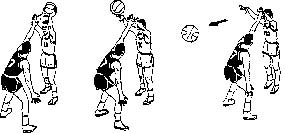
Push Pass:
The push pass is perhaps the most common pass used in basketball. It is called a "push pass" because the ball is pushed outwards from the shoulder using one hand.
From the "triple threat" position the pass is made as follows;
1-The wrist and forearm are "cocked" behind the ball.
2-Step into the pass (using either foot) and push the ball forward.
3-Snap the wrist and fully extend the arm. The other hand is only used to steady the ball until it is released.
4-All players must practice and become proficient at the push pass with both hands.

Dribbling skills:
You can't walk or run while holding the ball, so dribbling is a crucial skill.
You should master controlling the ball at speed and keeping it away from the opposition.
Remember, you can only use one hand at a time, and once you have stopped with the ball you have to pass or shoot, you cannot start dribbling again.
Here are the tips of basic basketball dribbling
- Use your finger tips to dribble, never the palm
- Dribble on the side of your body, never bounce the ball in front repeatedly
- Get used to bouncing the ball hard off the ground
- Lower your body slightly so that the ball is bouncing rapidly at waist level
- Look up when you are dribbling, not on the ground or on the ball
- When switching the ball from one hand to another, bounce the ball across hard and quick
- When changing direction, shift the momentum of your body towards that direction
STEP ONE
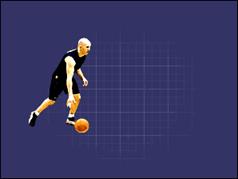
Gain control of the ball by spreading your fingers over the top.
Begin the dribble by pushing the ball firmly to the floor.
Use your hand, wrist and arm to control the height and speed of the bounce. Try to keep the ball at waist level.
STEP TWO
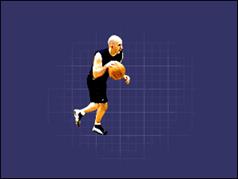
Keep your hand on top of the ball so it rebounds accurately, and try not to let the ball hit the palm of your hand.
Absorb the impact instead. Feel the ball with your fingers and let your wrists move the ball.
STEP THREE
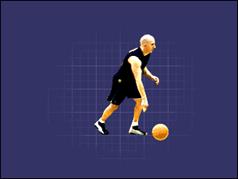
Move forward on the balls of your feet and bend your knees to maintain your balance.
Keeping your body over the ball will help to shield it from your opponents.
Practice while looking out in front of you, so you can assess your options, rather than down at the ball.
Shooting a basketball:
When you are thinking about your shooting technique, remember B-E-E-F. B - is for BALANCE, E - is for ELBOW, E - is for EYES, F - is for FOLLOW-THROUGH
Balance
1-Make sure you are "squared-up" to the basket.
2-Make sure your feet are about shoulder width apart, the "shooting foot" (the one on the same side as your shooting arm) slightly in front.
3-Knees bent for balance (and to provide "upward thrust" when you shoot).
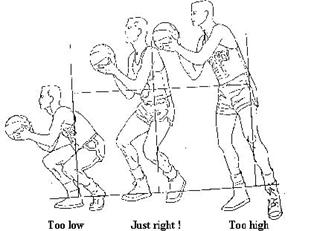
Elbow
1- Keep the elbow of your shooting arm close to your body -no "chicken wings".
2-During the shot the elbow should come up to your eyebrow level rather than going out in front of your body too much. This makes sure you get plenty of lift on the ball rather than pushing it out in front of you.
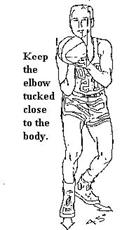
Eyes:
Keep your eyes on the target (the basket)! Don't watch the ball.
Follow-Through:
1. When you are holding the ball for the shot your wrist should be "cocked".
2. Release the ball off the fingers and snap the wrist back to put some backspin on the ball.
3. Keep your arm up in the air for a second - it should be like a "gooseneck". !
4. Point your index finger at the target at the end of the shot.
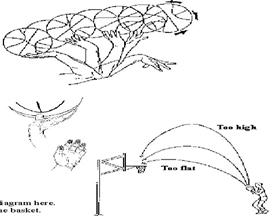
Angle of the Shot:
1. Try and give the ball a nice arc, like the middle line in the diagram here.
2. If you throw the ball too flat it will be harder to get it into the basket.
Holding the Ball:
1. If you are holding the ball correctly you should see a "Y" being formed by your thumb, fingers and forearm of your shooting arm.
2. You should hold the ball with the pads of the fingers and thumbs. There should be a gap between the palm of the hand and the ball.
3. The other hand only acts as a guide and is removed from the ball before the shot is released.

The Set shot:
This shot is used when you are standing still and close to the basket.
It is also the technique used for a free throw - an unopposed shot awarded after an opposing foul, and taken from the free-throw line.
STEP ONE
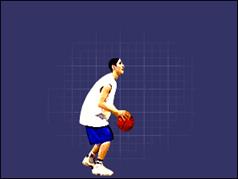
To begin the shot, crouch down with your knees apart and face the basket.
Your shooting hand should be behind the ball with the wrist cocked.
If you are a right-hand shooter, your right leg should be just ahead of your left as your knees bend.
STEP TWO

Make sure your shooting hand is facing the basket.
Start the shot by straightening your legs and transfer your weight slightly forwards.
With the ball in front of you, see yourself as springing up towards the basket.
STEP THREE

Pump your arm upwards so it straightens and aim to lift yourself up on to your toes.
Use your non-shooting hand to guide the ball and release it by flicking your wrist and fingers of your shooting hand.
Aim for the ball to loop quite high and concentrate on having a smooth and continuous action.
The lay-up shot:
Practicing and perfecting the art of shooting is crucial to the success of the team.
The lay-up shot is one of the most commonly used techniques - and you don't have to be 6ft-plus to find the net.
Begin by learning it from a standing start, then try and learn how to do it on the run.
That is not as easy as it looks, and a lot of young players have difficulty getting the footwork right and shooting off the correct foot.
But with a bit of practice, it's a banker for two points.
Eventually you should learn to use either hand, and eventually do the reverse lay-up.
STEP ONE
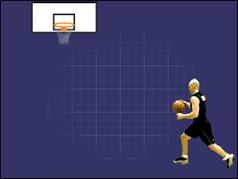
The overall aim is to drive towards the basket and score off the backboard.
Dribbling to the net from the side of the court should give you the space needed to make the jump.
If you are approaching from the right side and are right handed, take a half step with your outside (right) foot, then take a full stride to land on your inside (left) foot, using it to push off the court.
Launch yourself off your forward leg, and thrust your arms upwards towards the net to prepare for the shoot.
STEP TWO
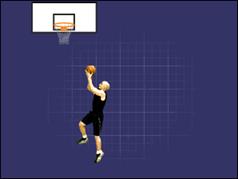
Bending the knee will help provide the spring needed - and keep defenders away.
STEP THREE
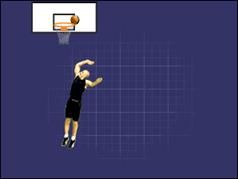
Aim to jump up towards the side of the basket and at the top of your leap, roll the ball to your shooting hand.
STEP FOUR
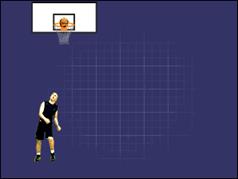
The ball should be released when the shooting arm and hands are at full stretch.
Try and lay the ball softly on to the backboard. If it's perfection you want, then hit the top corner of the rectangle on your side of the basket.
The jump shot:
This shot is useful if you are being closely marked.
A quick jump and release is required to get the ball over your opponent.
STEP ONE
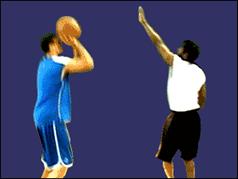
To give yourself a solid base, both of your feet should be flat on the floor.
With your body facing the basket, a low crouch will give you the momentum to make the jump.
STEP TWO
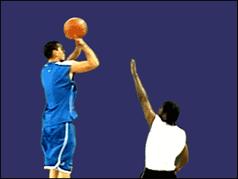
With the ball in both hands, rise up off your feet and prepare to shoot.
Your shooting hand should cup the ball and point towards the basket.
And your other hand can gently guide the shot from the side of the ball.
STEP THREE
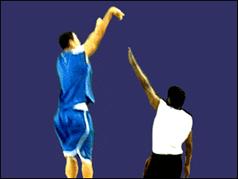
As your body straightens, spring off from the ground and shoot with both arms straightening.
A snap of the wrists and fingers should help with the release of the ball.
As you shoot, concentrate on the basket and not the ball. Extend your arms fully.
Basic Defensive Skills:
Defense is the key to winning a basketball game. Coaches want players who are willing to work hard at their defense. A good scorer who doesn't work hard on defense is less valuable than a hard-working defender who scores occasionally.
Good defense requires the following personal attributes;
- Willingness to work hard
- Concentration
- Aggressiveness
- Determination
- • Alertness
- You will also need to understand, and use, the following basic basketball skills;
- Correct stance
- Footwork (shuffle and drop step)
- Maintaining a good defensive position

Defensive Stance
1-Keep your feet about shoulder width apart.
2-Have one foot slightly in front of the other. Usually it should be the "inside" foot (the one that is nearest the centre of the court) that is in front. Dictate the direction the offense can take.
3-Keep your weight on the balls of your feet, don't stand flat-footed.
4-Knees bent, backside low, back straight.
5-Keep your head up.
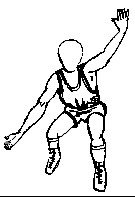
The position of your hands depends on whether your man (the one you are defending) is within his shooting range or not.
If your man is outside his shooting range (you think he cannot score from where he is) then;
-Keep your hands at about waist height with your palms facing up or out?
-If you want to try and knock the ball away, "dig up" at the ball rather than slapping down at it.
-Pressure the passing lanes.
If your man is inside his shooting range (you think he can score) then;
-Keep one hand high (at shoulder level) to pressure the shot and to block the shooters view of the basket.
-Keep the other hand low to guard against the dribble and pressure the passing lanes.
Defensive Position:
The most important thing to remember is;
ALWAYS STAY BETWEEN YOUR MAN AND THE BASKET HE IS SHOOTING AT
Guarding the man with the ball:
1-If he still has his dribble, stay about three feet away, keeping pressure on the ball and the shot with your hands.
2-If he has used his dribble then you can approach closer and increase the pressure.
Most players in our age group will dribble with mainly one hand (usually the right hand).In this case you should try and overplay them to that side (move to their right a bit), to try and force them to dribble or drive using their weaker dribbling hand.
Guarding a man without the ball :
Here the object is to stop the man from getting the ball.
You should still keep between your man and the basket, but take a position that allows you to put your hand and knee into the "passing lane". This is called the "deny" stance. Make sure to play a step towards the ball ("jump to the ball") to force you man to cut behind you and not in front. The "passing lane" is a straight line between your man and the ball.
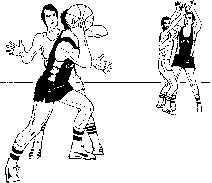
Offensive Moves:
The Triple Threat Position:
You should develop the habit of always going straight into the "triple threat" position when you get the basketball.
The triple threat position is,
1-Facing the basket
2-Feet about shoulder width apart.
3-Knees bent, keep your "behind" low.
4-Stay on the balls of your feet, don't stand flat-footed.
5-Keep your head up - looking around the court.
6-Holding the ball in the "ready" position, if closely guarded protect it on your back hip.

From the triple threat position you can,
1-dribble (drive to the basket)
2-pass
3-shoot
Remember to always "square up" to face the basket.
